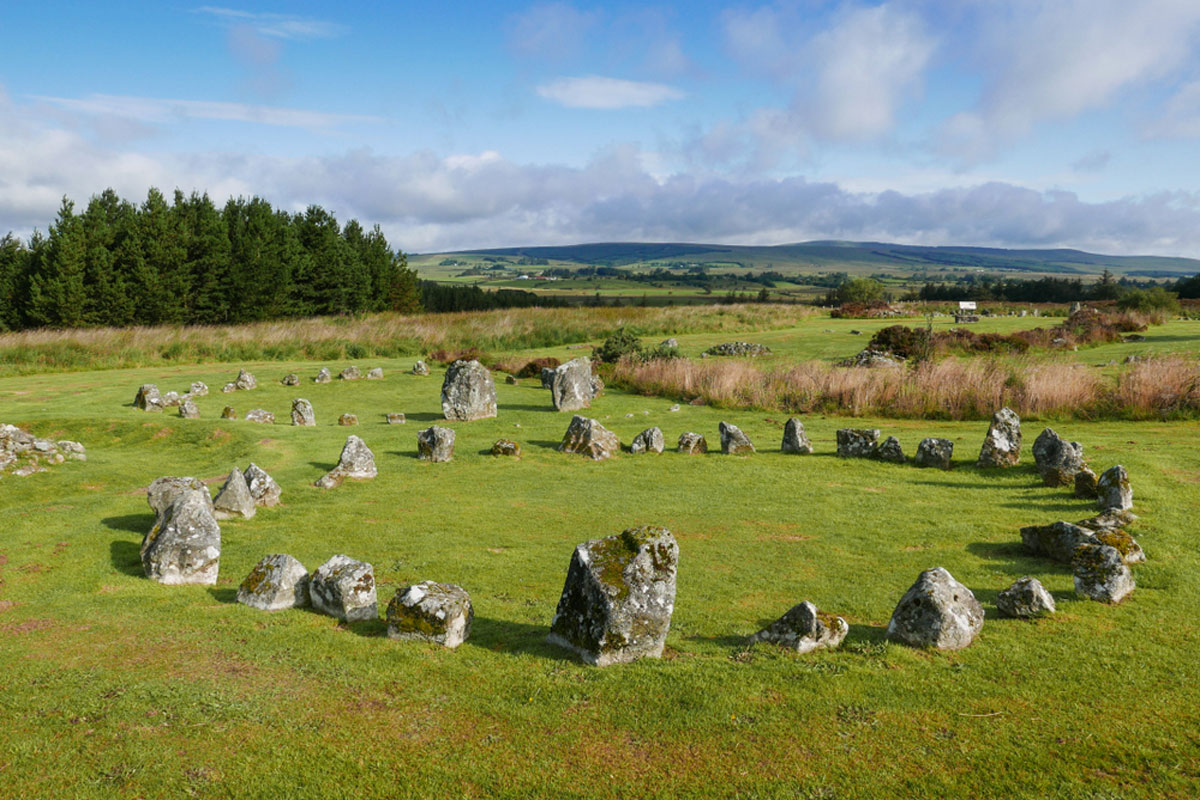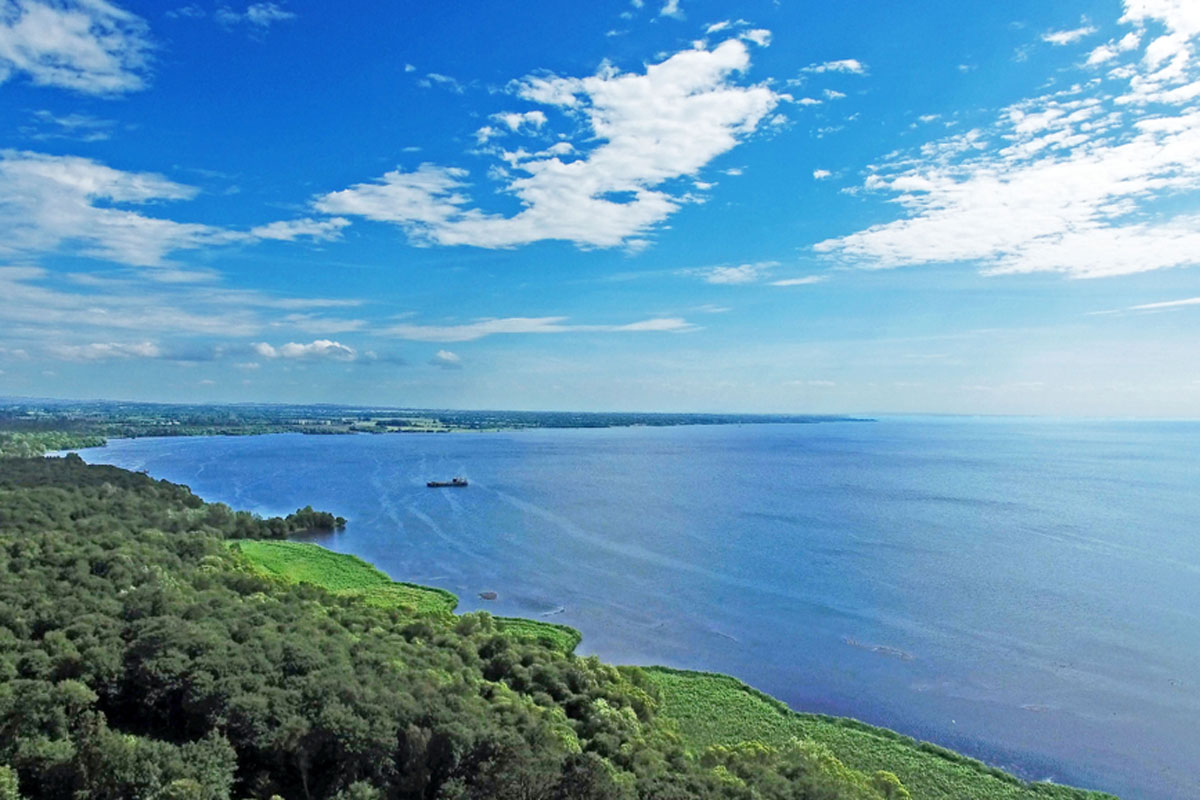The Origins of Beaghmore Stone Circles
Located near Cookstown in County Tyrone, Beaghmore Stone Circles is an extraordinary archaeological site that dates back to the early Bronze Age (approximately 1500-1200 BCE). The site is home to a collection of megalithic stone circles, alignments, and cairns that have intrigued historians, archaeologists, and visitors for centuries. This site offers a rare window into ancient rituals and practices, providing a connection to the distant past.
1. The Discovery of Beaghmore
Beaghmore was first discovered in the 1940s, but it wasn’t until the early 1970s that the site gained significant archaeological attention. During excavations, researchers uncovered an extensive network of stone circles, cairns, and other megalithic features that suggested the area had been used for ritualistic purposes.
While Beaghmore is often compared to other famous megalithic sites such as Stonehenge, it remains somewhat enigmatic due to the lack of written records from the time. Despite this, the site offers critical insights into the spiritual and ceremonial life of the people who lived during the Bronze Age.
2. The Layout of the Site
The Beaghmore Stone Circles are not just random clusters of stones; they are strategically positioned within the landscape to align with celestial events. The site features:
- Seven Stone Circles: These stone circles are the most prominent features at Beaghmore. Each circle is made of large stones, many of which are upright and arranged in a precise pattern.
- Cairns: Small stone mounds or cairns are scattered throughout the site, which likely served as burial sites or markers for significant locations.
- Stone Alignments: Several stone alignments stretch out across the landscape, possibly aligning with sunrises or sunsets at certain times of the year. This suggests that the site may have been used for astronomical observations or as part of seasonal rituals.
The positioning of these stones and structures suggests that the people who built Beaghmore had a deep understanding of the natural world, particularly the movement of the sun and moon.
3. The Purpose of the Site
While the exact purpose of Beaghmore Stone Circles remains a mystery, it is widely believed that the site was used for ritualistic and ceremonial practices. Possible functions include:
- Astronomical Observations: Some believe the site was used to track the movement of the sun, moon, and stars, helping to mark important events like solstices or equinoxes.
- Burial and Memorial Sites: The cairns and certain stone arrangements may have been used for burial rituals or as memorials for the deceased.
- Religious Ceremonies: As with other megalithic structures, the stone circles may have been part of pagan or Druidic ceremonies, representing a link between the earth and the heavens.
The design of the site, with its careful alignments and arrangement of stones, suggests that it had great spiritual significance to the people who constructed it.
4. A Unique Glimpse into the Past
Visiting Beaghmore today allows you to step back in time and experience a landscape unchanged for millennia. The site provides a rare opportunity to see the Bronze Age in its truest form, offering insights into the spiritual beliefs and practices of ancient people.
The surrounding natural beauty adds to the allure, with rolling hills and peaceful landscapes providing the perfect setting for these ancient stones.
Exploring the Features of Beaghmore Stone Circles
In the heart of the Beaghmore Stone Circles lies an intricate network of megalithic features, each carrying significance in the broader understanding of the site’s spiritual and ceremonial importance. The stone circles, cairns, and stone alignments found at Beaghmore offer fascinating insights into the rituals and practices of the Bronze Age. This part will take a deeper dive into the unique features of Beaghmore and their possible functions.
1. The Seven Stone Circles
The seven stone circles are the defining features of the Beaghmore site, each meticulously arranged to create a stunning and symbolic pattern. These stone circles vary in size, with the largest measuring up to 10 meters (33 feet) in diameter. Each circle consists of a set of upright stones, most of which are still in their original positions despite the passage of time.
- The Arrangement: The stones are arranged in regular, geometric patterns and likely served a specific function in the site’s ritualistic ceremonies. The alignment of the stones in each circle could have been designed to correspond to key astronomical events such as the solstices or the lunar cycles.
- The Material: The stones used in the circles are typically local limestone, with some weighing several tons. The construction of these circles would have required considerable effort, indicating that the people who built them were both skilled and dedicated.
- Symbolism: The circles may represent the cycle of life, the cosmic order, or could have had specific ritualistic significance related to life cycles or death and rebirth.
Each circle was likely used in ceremonial gatherings where community members performed rites related to the seasons, harvests, or celestial events, marking the passage of time and reinforcing their connection to nature and the cosmos.
2. The Cairns – Mounds of Mystery
Scattered around the Beaghmore site are several cairns, or small stone mounds, which further suggest the ritualistic nature of the site. These cairns are often found near the stone circles, and their placement hints at their religious and ceremonial significance.
- Burial Sites: The cairns may have been used as burial markers or memorials, potentially holding the remains of prominent individuals or serving as ritualized graves.
- Marker Stones: Some cairns are accompanied by large upright stones that could have been used as markers for important rituals or ceremonies. These stones could signify sacred spaces, boundaries, or directional alignment with the celestial bodies.
- Rituals of Remembrance: The cairns might also have served as places of offerings or rituals to honor the ancestors or gods, marking the sacred nature of the landscape.
While the exact purpose of the cairns remains uncertain, they undoubtedly played an important role in the spiritual life of the people who used the site.
3. The Stone Alignments – A Link to the Cosmos
Perhaps one of the most intriguing aspects of the Beaghmore Stone Circles is the alignments of stones that stretch across the landscape. These carefully positioned rows of stones may have served as astronomical markers, tracking the movement of the sun, moon, and stars.
- Astronomical Significance: The alignments may have been used to track celestial events, such as sunrise, sunset, or the lunar phases. This suggests that the site was not only used for religious ceremonies but also for observing the sky and seasonal changes, which was crucial for the ancient communities’ agricultural practices.
- Connection with Nature: The alignments are thought to mirror the natural cycles of the Earth, reinforcing the connection between the people and the cosmos. These stone alignments could have also been used to guide pilgrimages or mark specific routes during important festivals or rituals.
- Sacred Pathways: It is also possible that these alignments served as ritual pathways leading individuals from one area of the site to another, creating a symbolic journey that reflected both physical and spiritual movement.
The stone alignments at Beaghmore highlight the advanced knowledge of the ancient peoples and their deep connection to the natural and spiritual worlds.
4. The Landscape – A Sacred Setting
Beaghmore Stone Circles is not only remarkable for its megalithic structures but also for its strategic placement within the landscape. Situated on a plateau, the site offers sweeping views of the surrounding valleys and hills. This natural setting is integral to the site’s spiritual power, as it links the earthly and celestial realms.
- Orientation with the Sun and Moon: The site’s layout is aligned with the sun’s movement, specifically the winter solstice, which may have had significance for agricultural rites or seasonal celebrations.
- Natural Features: The landscape surrounding Beaghmore, with its rolling hills and vast expanses, likely played a role in the ceremonies, reinforcing the idea that the site was not just an architectural wonder but a sacred place embedded in the natural world.
The landscape, combined with the stone circles and alignments, creates an atmosphere that transports visitors back to a time when the land, the heavens, and the people were one.
Rituals and Ceremonies at Beaghmore Stone Circles
The Beaghmore Stone Circles is not just an archaeological site—it was once a place of deep spiritual significance, where the people of the Bronze Age gathered to engage in rituals that connected them to the natural world and the cosmic cycles.
1. Solar and Lunar Observations
One of the key aspects of Beaghmore Stone Circles is its likely use in astronomical rituals. The stone alignments, as well as the positioning of the circles, suggest that the site was used to track important celestial events such as the solstices, equinoxes, and phases of the moon. These observations were not merely for scientific curiosity but were deeply woven into the spiritual and agricultural life of the community.
- Winter Solstice Ceremonies: The alignment of certain stones at Beaghmore may have been designed to mark the winter solstice, an important event in many ancient cultures. For the people of Beaghmore, the solstice could have been a time to celebrate the return of the sun after the longest night of the year. Ceremonies at this time would have been centered around themes of rebirth, renewal, and the promise of light returning to the world.
- Lunar Rituals: The site’s careful alignment with the moon suggests it may have been used to track the lunar cycles, which were crucial for determining the best times for planting and harvesting. Full moons or eclipses could have been particularly significant, marking times for special rituals or offerings.
The movements of the sun and moon were likely seen as divine acts that needed to be acknowledged and honored through ceremonial practices at Beaghmore.
2. Seasonal Festivals and Agricultural Rituals
Agriculture played a central role in the life of the people who built Beaghmore, and many of the site’s rituals were likely tied to the changing seasons and the rhythms of nature. As agricultural societies, early Bronze Age communities would have based much of their ritual calendar around the growth and harvest cycles of the crops they depended on.
- Harvest Festivals: Beaghmore’s stone circles might have been the site of rituals to celebrate the harvest or to give thanks for the bounty of the land. These ceremonies could have included offerings of food, grain, or other agricultural products to ensure future prosperity.
- Planting and Fertility Rites: As the seasons changed, rituals at Beaghmore would likely have been conducted to invoke fertility and ensure a successful growing season. The stones themselves may have symbolized the fertile earth, and rituals could have involved symbolic actions like dancing, singing, or the pouring of liquids to honor the land and its cycles.
- Connection to the Earth: Through these rituals, the people of Beaghmore would have felt a strong connection to the earth, believing that their actions in the physical world could influence the success of their crops and the health of their community.
These seasonal festivals would have been times of community bonding, as people came together to mark important points in the agricultural cycle.
3. Ancestor Worship and Funerary Practices
The presence of cairns at Beaghmore, along with its overall layout, suggests that the site was also a center for ancestor worship and funerary practices. In early Bronze Age cultures, it was common to honor the deceased through burial rites and memorial rituals, and Beaghmore was likely no exception.
- Burial Cairns: Many of the cairns at Beaghmore could have served as burial sites, where important individuals, perhaps tribal leaders or spiritual figures, were laid to rest. The cairns might have been used as markers for these graves, with the surrounding stones symbolizing the connection between the living and the dead.
- Ritual Offerings: During ceremonial events at Beaghmore, people may have made offerings to the ancestors, such as food, symbolic items, or libations poured onto the stones. These offerings would have been meant to honor the dead and perhaps seek their favor or guidance.
- The Afterlife and Spiritual Beliefs: The importance of death and the afterlife is often reflected in the way early cultures treat burial sites and memorials. The rituals at Beaghmore may have focused on spiritual continuity, ensuring that the deceased were properly honored and that their spirits remained active and influential within the community.
The cairns and stones, alongside these rituals, would have helped to maintain a connection to the ancestors, reinforcing the idea that the living and the dead were part of an eternal cycle.
4. The Role of the Community in Rituals
Rituals at Beaghmore were not just solitary acts but would have been collective affairs, involving the participation of the entire community. These ceremonies were likely public events, where families, tribes, or clans gathered at the site to perform the rituals together.
- Sacred Gatherings: The stone circles and cairns would have served as a sacred space for these gatherings, creating a communal sense of unity and devotion. The act of coming together in such a ritually significant place would have reinforced the bonds between individuals and their shared beliefs.
- Ceremonial Performances: The ceremonies themselves may have included chanting, dancing, and ritual sacrifices, all intended to honor the gods, ancestors, or natural forces. The stones might have been touched or circled in specific patterns as part of these symbolic acts.
- Spiritual Community: These shared experiences would have reinforced the idea of the community’s spiritual life, ensuring that each individual played a role in maintaining the balance between earth and the heavens.
The rituals at Beaghmore were not just about religious devotion; they were a way of life for the ancient people who built the site. Through their astronomical observations, seasonal festivals, and ancestor worship, they connected with the cycles of nature and the cosmos in a way that transcended everyday life. These practices reinforced their belief in the sacredness of the world around them and their place in the natural order.
Preservation and Significance of Beaghmore Stone Circles
The Beaghmore Stone Circles are a remarkable relic of the Bronze Age, and their preservation has allowed modern visitors to experience a tangible connection to ancient rituals and beliefs.
1. Preservation Efforts at Beaghmore
Beaghmore is a protected archaeological site, and significant efforts have been made to preserve its structures for future generations. Over the years, there have been several steps to ensure that the stone circles, cairns, and alignments remain intact despite the challenges posed by natural elements and human activity.
- Site Management: The site is managed by Northern Ireland Environment Agency (NIEA), which oversees its conservation. Regular surveys and maintenance work are carried out to monitor the condition of the stones and to ensure that the site remains accessible to visitors.
- Visitor Restrictions: In order to protect the integrity of the site, certain restrictions have been put in place. For example, visitors are encouraged to remain on marked paths to avoid disturbing the stones or causing erosion of the landscape. These measures ensure that the site’s cultural significance is preserved while still allowing the public to engage with it.
- Archaeological Research: Archaeologists continue to study Beaghmore to learn more about its construction, the people who built it, and the rituals that took place there. Ongoing excavation projects and non-invasive studies, such as ground-penetrating radar, help to uncover new information while protecting the site from unnecessary disturbance.
Through these efforts, Beaghmore remains a living testament to ancient practices and continues to provide valuable insights into the prehistoric past.
2. Beaghmore’s Importance to Local Heritage
The Beaghmore Stone Circles hold a special place in the cultural identity of County Tyrone and the wider Northern Ireland region. They are an essential part of the area’s local heritage and are celebrated as one of the region’s most significant archaeological sites.
- Cultural Pride: Beaghmore is seen as a symbol of the deep history of the area, representing the ancient peoples who lived and thrived in the region thousands of years ago. Local communities take great pride in the site, and it serves as a reminder of the rich cultural tapestry that has shaped the region.
- Educational Value: Beaghmore plays a key role in educating both locals and visitors about the Bronze Age and its archaeological significance. Schools, universities, and research institutions use the site to study ancient cultures and archaeological methods, fostering a deeper understanding of Ireland’s ancient past.
- Cultural Events and Engagement: Beaghmore is also a cultural touchstone for local festivals and community events, bringing people together to celebrate the region’s heritage. These events often feature historical reenactments, guided tours, and talks that help the public connect with the site’s ancient significance.
3. Beaghmore’s Global Archaeological Significance
While Beaghmore is an integral part of local heritage, its importance extends far beyond Northern Ireland. The site is considered an essential piece of the global puzzle in understanding the Bronze Age and the development of early megalithic cultures.
- Comparative Studies: Beaghmore is often compared to other megalithic sites across Europe, such as Stonehenge in England and Newgrange in Ireland. Researchers and archaeologists use Beaghmore as a point of comparison to understand the widespread use of stone structures in early societies and how they might have influenced one another.
- Insights into Early Rituals: Beaghmore’s well-preserved features offer crucial insights into early religious practices, including astronomical observations, seasonal rituals, and burial customs. The site is an invaluable resource for understanding the spiritual and cultural life of early societies in Ireland and beyond.
- Megalithic Studies: As a megalithic site, Beaghmore is part of a larger network of ancient stone structures that reveal the complexity and sophistication of early human societies. The continued study of Beaghmore helps to expand our understanding of how these structures were used and what they tell us about human development and belief systems.
4. The Role of Beaghmore in Modern Tourism
In addition to its cultural and academic significance, Beaghmore has become an important destination for tourists, particularly those interested in archaeology, history, and natural beauty. The site offers a chance to walk through history, immerse oneself in the landscape, and explore Ireland’s ancient past.
- Visitor Experience: Beaghmore is accessible to visitors year-round, with guided tours available for those who wish to learn more about the site’s history, construction, and cultural importance. The serene surroundings also provide a peaceful setting for those simply looking to enjoy the landscape and reflect on the site’s rich history.
- Tourism Impact: The site has a positive impact on the local economy, drawing visitors from around the world who come to explore the stone circles and experience the ancient landscape. The economic benefits from tourism help support the preservation efforts and ensure that the site remains accessible for future generations.
- Community Involvement: Local residents and tourism organizations play a key role in promoting Beaghmore as a cultural attraction, ensuring that visitors receive a welcoming experience while respecting the site’s heritage.
5. Conclusion: A Legacy for the Future
Beaghmore Stone Circles stand as a remarkable reminder of Ireland’s ancient past. Through careful preservation, research, and community engagement, the site continues to offer a connection to the Bronze Age and the ancient people who once lived in the region. Its astronomical alignments, ritual significance, and unique stone arrangements make it an invaluable cultural and historical treasure, not only for Northern Ireland but for the world.
Visiting Beaghmore today offers a chance to walk in the footsteps of those who once used the site to connect with the cosmos, honor their ancestors, and mark the changing seasons. As the site continues to be preserved and studied, its importance will only grow, serving as a testament to the ingenuity and spiritual life of the ancient communities that once thrived here.
County Tyrone, located in Northern Ireland, is a land of natural beauty, historical significance, and vibrant culture. Here’s a guide to its most notable tourist attractions:
Historical and Cultural Sites
- Ulster American Folk Park: An open-air museum exploring the history of Irish emigration to America.
- Hill of The O’Neill and Ranfurly House, Dungannon: A historic site with panoramic views and exhibitions on the O’Neill dynasty.
- Wellbrook Beetling Mill: A restored 19th-century mill showcasing the linen-making process.
- Beaghmore Stone Circles: A complex of Bronze Age stone circles and cairns in the Sperrin Mountains.
- Dun Uladh Heritage Centre: A hub for traditional Irish music, dance, and culture.
Natural Attractions
- Gortin Glen Forest Park: A stunning area with walking trails, picnic spots, and scenic drives through the Sperrin Mountains.
- Davagh Forest and Dark Sky Park: A haven for stargazers, offering some of the darkest skies in Ireland.
- Sperrin Mountains: A vast range ideal for hiking, cycling, and soaking in breathtaking views.
- Lough Neagh: The largest freshwater lake in the UK and Ireland, perfect for boating and birdwatching.
- Loughmacrory: A tranquil lake surrounded by walking trails and stunning scenery.
Scenic Drives and Villages
- Omagh: The largest town in Tyrone, known for its vibrant arts scene and cultural attractions like the Strule Arts Centre.
- Dungannon: A historic town with ties to the ancient Gaelic O’Neill clan.
- Cookstown: Famous for its wide main street, bustling market, and proximity to the Beaghmore Stone Circles.
- Castlederg: A charming village with riverside walks and a rich history.
- Aughnacloy: A picturesque village near the Tyrone/Monaghan border, ideal for exploring rural life.
Lakes and Water Activities
- Lough Neagh: Offers fishing, kayaking, and boat tours, with charming spots like Ballyronan Marina.
- Loughmacrory: Great for walking and enjoying peaceful lakeside views.
- River Blackwater: Perfect for canoeing and exploring the scenic waterways of Tyrone and Armagh.
- Ballysaggart Lough: A small but picturesque lake near Dungannon.
- River Mourne: Popular for salmon and trout fishing in serene surroundings.
Unique Experiences
- An Creagán Visitor Centre: A hub for exploring local heritage, with craft workshops, nature trails, and traditional Irish food.
- Todds Leap Activity Centre: An adrenaline-filled experience offering ziplining, off-road driving, and paintball.
- Davagh Forest Trails: Perfect for mountain biking and stargazing in the Dark Sky Park.
- Baronscourt Estate: A stunning private estate offering fishing, walking, and glimpses of red deer.
- Glenpark Estate: A family-friendly destination featuring wildlife, a restaurant, and outdoor activities.
County Tyrone is a captivating mix of ancient history, natural splendor, and modern attractions. From exploring the Sperrin Mountains to delving into the stories of emigration at the Ulster American Folk Park, Tyrone promises a rich and memorable experience for all visitors.
Helpful Resources






